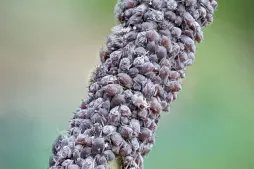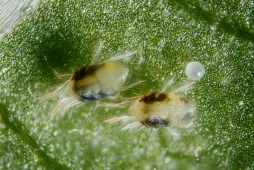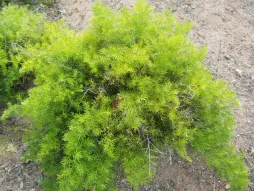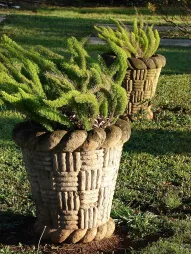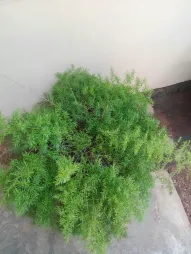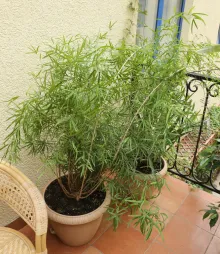Asparagus setaceus, the florist's asparagus
For a long time, Asparagus setaceus was a stooge. Florists used its airy foliage to embellish their bouquets. But this member of the Asparagaceae family can also shine on its own. In the ground, indoors or in a terrarium, it brings a little lightness to our daily lives.
How to recognize Asparagus setaceus, the florist's asparagus?
In the savannahs of Africa, Asparagus setaceus reaches over a metre in height. In our latitudes, in pots or in the ground, its size is more modest. It doesn't exceed 50 centimetres in height and 60 centimetres in spread. This herbaceous perennial has an upright or spreading habit.
Dark tuberous roots wind underground. On the surface, bright-green stems protrude. Asparagus sprengeri has sharp spines.
Flowering asparagus appears to have small, acid-green leaves. These are actually cladodes, twigs no more than seven millimetres long and one millimetre in diameter. They appear in clumps, giving the stems a parasol-like appearance.
The male and female flowers are on different feet. White or slightly greenish yellow, they rarely bloom indoors.
They change into a green, then black berry. The fruit contains the seed, which is spread by birds.
The plant is toxic to us and our pets. It causes stomach ache when its berries are eaten. Its cladodes and spines can also cause skin reactions. Remember to wear gloves when handling your Asparagus setaceus!
Our maintenance tips
Your Florist's asparagus needs light. But its delicate foliage cannot withstand the strongest sunlight. Indoors, place the plant behind a window screened by a curtain. Outdoors, prefer half-shade.
Watering
Allow the rootball to dry out to one centimeter between waterings. Water generously with non-calcareous water (rainwater, for example) at room temperature.
Drain off any excess water left in the dish or planter. It can rot the roots.
Spray
Mist the foliage with non-calcareous water at room temperature. This will temporarily increase humidity and prevent pest attacks.
Repotting
Every spring, repot your Asparagus setaceus to give it more space.
Choose a pot with holes larger than the root ball. Use a plastic pot rather than a terracotta one. This material retains more moisture. Moreover, the plant develops vigorous roots. It is not uncommon for them to break clay containers. Plastic is more resistant.
Pour a layer of potting soil for green plants at the bottom of the pot. Plant your subject in the center and fill in with substrate.
Press down and water generously to remove air bubbles.
Your Florist's asparagus doesn't like too dry an atmosphere. Place the pot on a dish filled with moist clay balls to improve humidity.
Fertilization
To promote the growth of your Asparagus setaceus, apply fertilizer in spring and summer.
Fertilize your Florist's asparagus with a green plant fertilizer to support growth. Remember to halve the dose prescribed by the manufacturer.
Prune
Cut back older stems to one or two centimetres from the ground to encourage new branches.
Prune branches to balance shape and maintain a compact habit.
Plantation
When the risk of frost has passed, it's time to plant.
Choose a well-exposed location, away from direct sunlight.
Dig a hole about 25 centimetres deep. Place a layer of compost at the bottom to enrich the soil. Work the soil to loosen it. If necessary, add sand.
Plant your Florist's asparagus without burying the crown. Fill in and water to encourage rooting.
If you're building a bed, keep a 50-centimeter spacing between the various specimens.
Cutting
Cutting is carried out during the strong growth phase, generally in spring and early summer.
When repotting, divide the plant in two or three. Remove the soil from the roots to better locate the rhizomes. Using a clean knife or serpette, cut the roots. Be careful not to cut the tubers.
Pour potting soil for green plants into a drilled pot. Make a pilot hole with a pen or pick. Plant your cutting in the center
Press lightly to remove air bubbles and water with room-temperature water to encourage rooting.
Place your cutting in a bright spot, but away from direct sunlight.
Diseases / Threats
Information
| Family | Asparagaceae - Asparagaceae |
| Type | Asparagus - Asparagus |
| Species | Florist's asparagus - Asparagus setaceus |
| Lifecycle | Perennial |
| Foliage | Evergreen |
| Exposures | |
| Substrat | |
| Planting methods |
Open ground In pots In tubs Planter |
| Categories | |
| Tags |
Beginner Toxic |
| Origin |
South Africa |
| Hardiness (USDA) | 11a |
| Leaf color |
|
| Flower colors |
|
| Fruit color |
|
Discover plants from the same family













